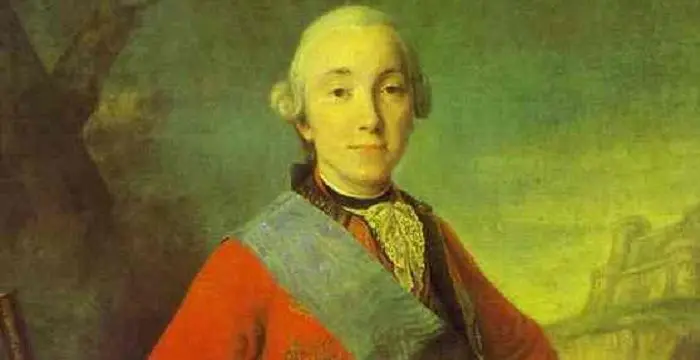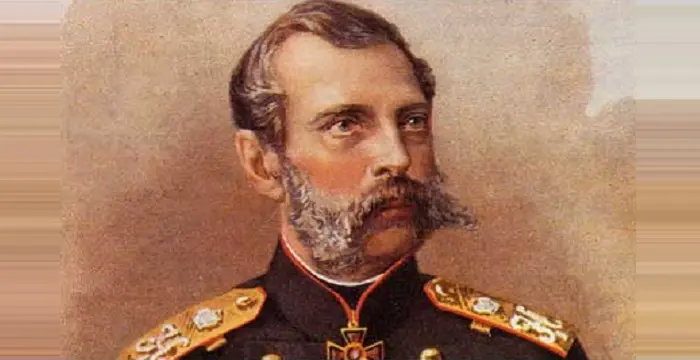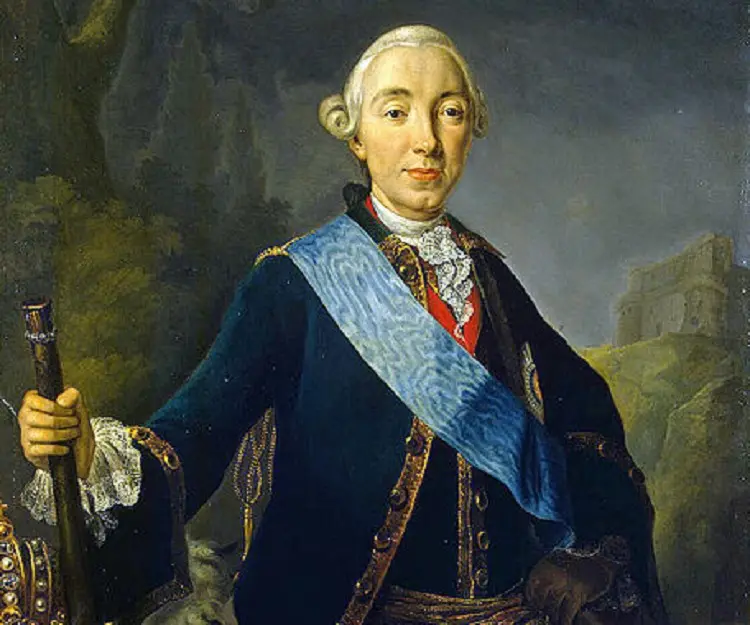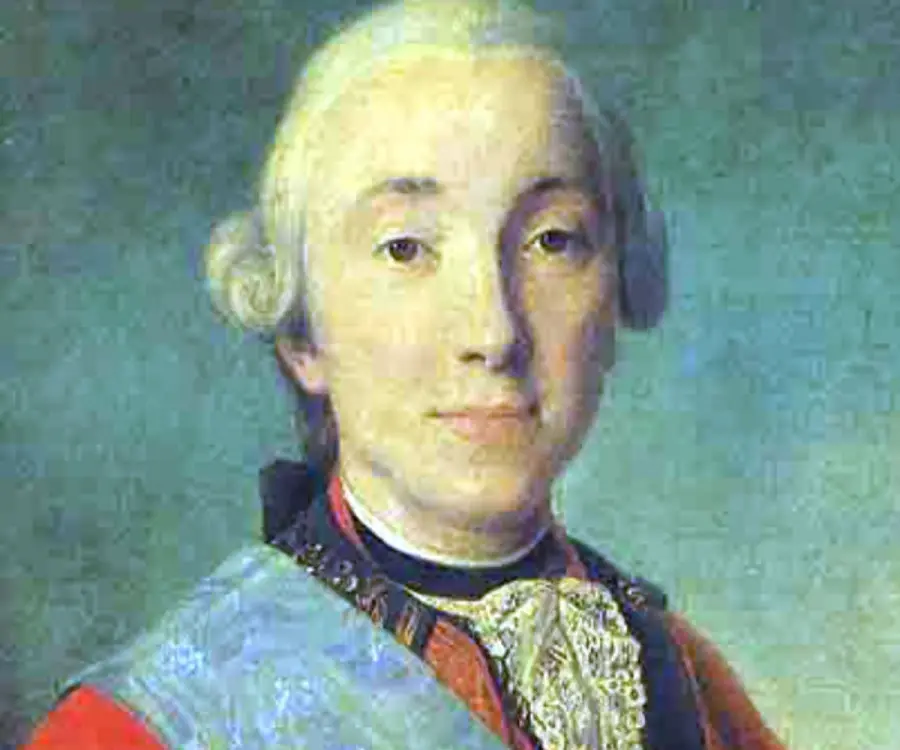
Peter III of Russia - Kings, Birthday and Childhood
Peter III of Russia's Personal Details
Peter III was the Emperor of Russia who served for merely six months, before he was deposed in 1762
| Information | Detail |
|---|---|
| Birthday | February 21, 1728 |
| Died on | July 17, 1762 |
| Nationality | Russian |
| Famous | Historical Personalities, Emperors & Kings, Emperor of Russia, Emperors, Kings |
| Spouses | Catherine the Great |
| Childrens | Paul I of Russia |
| Cause of death |
|
| Birth Place | Kiel |
| Religion | Eastern Christianity, Orthodox Christianity |
| Gender | Male |
| Father | Charles Frederick, Duke of Holstein-Gottorp |
| Mother | Grand Duchess Anna Petrovna of Russia |
| Sun Sign | Pisces |
| Born in | Kiel |
| Famous as | Emperor of Russia |
| Died at Age | 34 |
// Famous Emperor of Russia
Alexander II of Russia
Alexander II of Russia was the Emperor of Russia, as well as the King of Poland and the Grand Duke of Finland, who reigned from March 1855 to March 1881. Check out this biography to know about her childhood, life and achievements
Peter III of Russia's photo
Who is Peter III of Russia?
Peter III was the Emperor of Russia who served for merely six months, before he was deposed in 1762. Born to Charles Frederick, Duke of Holstein-Gottorp and Anna Petrovna, he was the only child of the couple. He was the grandson of two Emperors, Peter the Great of Russia and Charles XII of Sweden. Upon the death of his parents, Peter was groomed to take up the Swedish throne in future. However, destiny had other plans for him. At the age of 14, he was taken to Russia by his aunt who pronounced him as her successor. Peter’s pro-Prussian policies and lack of Russian language made him unpopular amongst his subjects who tagged him as a betrayer for signing of the peace treaty. His personality and policies did not go well with the aristocrats and nobility who feared his modernized ways and techniques. It was due to his unpopularity that he was deposed from the seat of the Emperor. Astonishingly, it was his wife, Catherine who was the mastermind behind the conspiracy to depose him. It is rumoured that she not just conspired his dethronement but his assassination as well
// Famous Kings
Sundiata Keita
Sundiata Keita was the founder of the Mali Empire in West Africa. This biography profiles his childhood, early life, struggles, founding of empire, rule, administration, achievements and also gives some fun facts.
Ashoka
Ashoka was the third emperor of the Mauryan Dynasty and ruled almost the entire Indian subcontinent. This biography profiles his childhood, life, reign, achievements and timeline
Murad IV
Murad IV was one of the mighty Sultans in the history of the Ottoman Empire. This biography profiles his childhood, family, accession, rule, administration and timeline.
Childhood & Early Life
Peter III was born as Karl Peter Ulrich to Charles Frederick, Duke of Holstein-Gottorp and Anna Petrovna on February 21, 1728 in Kiel, Duchy of Holstein-Gottorp. He was the only child born to the couple. While his maternal grandfather was Peter the Great of Russia, his paternal grandfather was Charles XII of Sweden.
Young Peter lost his parents early, his mother having died only three months after his birth and his father passed away in 1739. Upon the death of his father, he became Duke of Holstein-Gottorp as Charles Peter Ulrich.
Orphaned at an early age, Peter was put under the care of marshals and warriors in the court of Holstein. Academically weak, Peter was cruelly raised by his mentors who often punished him for his inept aptitude. Since it was known that Peter would inherit the Swedish throne in future, they trained him accordingly.
Though Peter was not so good in academics, he had an intense passion for arts. He was fond of music and painting and showed an appetite for military parades and uniforms. He longed to become a world-famous military warrior.
In 1742, when his aunt Elizabeth took over as the Empress of Russia, she brought the fourteen-year old Peter to Russia and proclaimed him as the heir presumptive to the Russian throne. Same year, Peter was proclaimed as the King of Finland, a position originally held by Charles XII of Sweden.
Following his baptism in the Russian Orthodox Church, his name was changed to Pyotr Fyodorovich. He came under the guidance of academician Yakob Shtelin. Peter resented living in Russia. A pro-Prussian, he could hardly speak Russian and often complained of being an unacceptable leader of the people.
Unaware that Peter was chosen as the heir presumptive to the Russian throne, the Swedish parliament too announced him as the heir presumptive to the Swedish throne. It was only later that underage Peter’s succession right to Sweden throne were renounced on his behalf.
Accession & Reign
During Empress Elizabeth’s rule, she isolated Peter from government affairs and hardly allowed him to participate in the politics of the country, as she suspected his capabilities as a leader. This led to a growing sense of resentment in Peter against Russian government.
Peter hated being in Russia and continued to show his allegiance towards his homeland and Prussia by criticizing the Russian government and the Empress. His sympathetic attitude towards Prussia gained him negative publicity as he was condemned by the people and became highly unpopular.
Upon the death of Empress Elizabeth on December 25, 1761, Peter succeeded to the Russian throne. Pressed to prove his worth to the Russian people, Peter who was then Peter III brought forth a number of domestic and foreign policies, though none were worthy.
Immediately after taking up the throne, he withdrew the Russian forces from the Seven Years’ War by signing a peace treaty with Prussia. Furthermore, he gave up Russian conquests in Prussia and instead made an alliance with the Prussian King by offering 12000 troops. This alliance made Prussia most powerful in Europe.
During his reign, he planned war against Denmark to regain the native land of Holstein that once belonged to his father. With the help of Frederick of Prussia, he planned war against Denmark. The move was seen as a betrayal of Russian war sacrifices and alienated him politically among the military and powerful court cliques.
Just like his foreign policies which were reverse of Empress Elizabeth’s plans, his domestic policies too were rebellious in nature. In the six months of his reign, he came up with 220 new laws for the Russian people that are today claimed as being democratic.
Peter allowed religious freedom to his subjects, a move unheard of in those times. It was revolutionary and way ahead of times as the then highly advanced Western Europe also did allow spiritual freedom.
To fight corruption within the government, he abolished the secret police and established public litigation. He outlawed the killing of serfs by the landowners and gave state peasants a high social status than estate peasants. He converted peasants under the servitude of the church to economy peasants.
Peter made education obligatory for aristocrats and went ahead to establish technical schools for middle and lower class children. He also began reorganization and modernization of the Russian army.
He established the first state bank in Russia and encouraged mercantilism by increasing grain exports and placing embargos on materials that could be found in Russia, thus rejecting the monopoly of the nobility. Besides, he forbade import of sugar and other materials that were found in Russia.
His most popular reform was releasing the gentry from compulsory state and military service. This gave them the freedom to travel abroad. Furthermore, he issued an edict that the new owner of monastery lands was the state, not the church. The move not just replenished the treasury, but freed the state from the powers of the church.
Peter was condemned by the Russian society as his actions were considered unreasonable for those times. Also, they believed that through his reforms, he alienated the Orthodox Church and the nobility. His policies were considered bizarre by state officials and the aristocrats who turned to his wife Catherine for help.
With the help of nobility and the army, Catherine plotted the dethronement of Peter III as the Emperor. She was the mastermind behind the conspiracy. On June 28, 1762, the army swore allegiance to Catherine, and she was pronounced the new Empress of Russia. The Senate and the Synod also pledged to support her. Thus, Peter III was forced to step down as the emperor.
Major Works
In his short span of service as the Emperor of Russia, Peter carried out several military and domestic reforms. While the former were unpopular for his pro-Prussian ways, the latter seemed way too advanced for the people of those times. He allowed religious freedom to his subjects, abolished the secret police and established public litigation to fight corruption, outlawed the killing of serfs by the landowners, made education obligatory and established the first state bank in Russia. However, his most important contribution came in when he released the gentry from compulsory state and military service. Also, he gave the state greater powers than the church, a move that was highly detested.
Personal Life & Legacy
Immediately following his baptism to the Russian Orthodox Church, his aunt, Empress Elizabeth arranged Peter’s marriage to Sophia Augusta Frederica who later became Catherine the Great. The marriage took place on August 21, 1745. They had two children, a son and daughter.
The marriage of Peter and Catherine was essentially a political alliance and had nothing personal. The two were extremely opposite of each other; she was prodigiously talent while Peter was of low intellect. Catherine is said to have claimed that the marriage between the two never consummated and that Peter did not father her children. Both of them had numerous lovers outside marriage.
Emperor Peter III’s accession to the Russian throne was not welcomed by the society who abhorred his modernized laws and policies. The nobility and the Church feared losing the control and thus turned to his wife, Catherine for help. She, in turn, supported them by becoming the mastermind behind his dethronement. On June 28, 1762 she successfully overthrew him to become the Empress Catherine of Russia.
Following his dethronement, he was sent to a village, Ropsha, near St Petersburg. He breathed his last on July 17, 1762. Though his death was initially seen as an accident, it later became evident that he was assassinated. He was buried in the church of Aleksandr Nevsky Monastery in Saint Petersburg.
Posthumously in 1796, his remains were exhumed and reburied with full state honours in Peter and Paul Cathedral by his son, Emperor Paul.
// Famous Emperors
Sundiata Keita
Sundiata Keita was the founder of the Mali Empire in West Africa. This biography profiles his childhood, early life, struggles, founding of empire, rule, administration, achievements and also gives some fun facts.
Ashoka
Ashoka was the third emperor of the Mauryan Dynasty and ruled almost the entire Indian subcontinent. This biography profiles his childhood, life, reign, achievements and timeline
Murad IV
Murad IV was one of the mighty Sultans in the history of the Ottoman Empire. This biography profiles his childhood, family, accession, rule, administration and timeline.
Peter III of Russia biography timelines
- // 21st Feb 1728Peter III was born as Karl Peter Ulrich to Charles Frederick, Duke of Holstein-Gottorp and Anna Petrovna on February 21, 1728 in Kiel, Duchy of Holstein-Gottorp. He was the only child born to the couple. While his maternal grandfather was Peter the Great of Russia, his paternal grandfather was Charles XII of Sweden.
- // 1739Young Peter lost his parents early, his mother having died only three months after his birth and his father passed away in 1739. Upon the death of his father, he became Duke of Holstein-Gottorp as Charles Peter Ulrich.
- // 1742In 1742, when his aunt Elizabeth took over as the Empress of Russia, she brought the fourteen-year old Peter to Russia and proclaimed him as the heir presumptive to the Russian throne. Same year, Peter was proclaimed as the King of Finland, a position originally held by Charles XII of Sweden.
- // 21st Aug 1745Immediately following his baptism to the Russian Orthodox Church, his aunt, Empress Elizabeth arranged Peter’s marriage to Sophia Augusta Frederica who later became Catherine the Great. The marriage took place on August 21, 1745. They had two children, a son and daughter.
- // 25th Dec 1761Upon the death of Empress Elizabeth on December 25, 1761, Peter succeeded to the Russian throne. Pressed to prove his worth to the Russian people, Peter who was then Peter III brought forth a number of domestic and foreign policies, though none were worthy.
- // 28th Jun 1762With the help of nobility and the army, Catherine plotted the dethronement of Peter III as the Emperor. She was the mastermind behind the conspiracy. On June 28, 1762, the army swore allegiance to Catherine, and she was pronounced the new Empress of Russia. The Senate and the Synod also pledged to support her. Thus, Peter III was forced to step down as the emperor.
- // 28th Jun 1762Emperor Peter III’s accession to the Russian throne was not welcomed by the society who abhorred his modernized laws and policies. The nobility and the Church feared losing the control and thus turned to his wife, Catherine for help. She, in turn, supported them by becoming the mastermind behind his dethronement. On June 28, 1762 she successfully overthrew him to become the Empress Catherine of Russia.
- // 17th Jul 1762Following his dethronement, he was sent to a village, Ropsha, near St Petersburg. He breathed his last on July 17, 1762. Though his death was initially seen as an accident, it later became evident that he was assassinated. He was buried in the church of Aleksandr Nevsky Monastery in Saint Petersburg.
// Famous Historical Personalities
Sundiata Keita
Sundiata Keita was the founder of the Mali Empire in West Africa. This biography profiles his childhood, early life, struggles, founding of empire, rule, administration, achievements and also gives some fun facts.
Ashoka
Ashoka was the third emperor of the Mauryan Dynasty and ruled almost the entire Indian subcontinent. This biography profiles his childhood, life, reign, achievements and timeline
Jetsun Pema
Jetsun Pema is the Queen consort of Bhutan. Check out this biography to know about her childhood, family life, achievements and fun facts about her life.
Murad IV
Murad IV was one of the mighty Sultans in the history of the Ottoman Empire. This biography profiles his childhood, family, accession, rule, administration and timeline.
Xerxes I
Xerxes I (Xerxes the Great) was the fourth and the most famous king of the Archaemenid dynasty of Persia. This biography profiles his childhood, family, personal life, life history, achievements, campaigns, administration, death and other facts.
Sargon of Akkad
Sargon of Akkad, also called ‘Sargon the Great’, ‘Sarru-Kan’ and ‘Shar-Gani-Sharri’, was the founder and first king of the Akkadian Empire. This biography profiles his childhood, life, rule, administration, timeline, and gives some fun facts.
Peter III of Russia's FAQ
What is Peter III of Russia birthday?
Peter III of Russia was born at 1728-02-21
When was Peter III of Russia died?
Peter III of Russia was died at 1762-07-17
Where was Peter III of Russia died?
Peter III of Russia was died in Ropsha
Which age was Peter III of Russia died?
Peter III of Russia was died at age 34
Where is Peter III of Russia's birth place?
Peter III of Russia was born in Kiel
What is Peter III of Russia nationalities?
Peter III of Russia's nationalities is Russian
Who is Peter III of Russia spouses?
Peter III of Russia's spouses is Catherine the Great
Who is Peter III of Russia childrens?
Peter III of Russia's childrens is Paul I of Russia
What is Peter III of Russia's cause of dead?
Peter III of Russia dead because of Assassination
What is Peter III of Russia's religion?
Peter III of Russia's religion is Eastern Christianity, Orthodox Christianity
Who is Peter III of Russia's father?
Peter III of Russia's father is Charles Frederick, Duke of Holstein-Gottorp
Who is Peter III of Russia's mother?
Peter III of Russia's mother is Grand Duchess Anna Petrovna of Russia
What is Peter III of Russia's sun sign?
Peter III of Russia is Pisces
How famous is Peter III of Russia?
Peter III of Russia is famouse as Emperor of Russia









